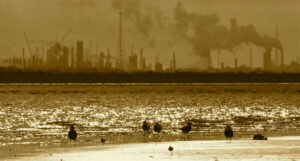What The Fact?
Does Shell’s carbon capture Quest project contribute to lowering CO2 emissions?
Photo: A Shell garage by night. Photo by Szabolcs Toth in Budapest, Hungary on November 26, 2020 via Unsplash
The Claim
‘In its fifth year operating, Quest continues to be a thriving example of how carbon capture and storage is working; showing it can make a significant contribution to lowering CO2 emissions and at a lower cost than anticipated – Michael Crothers, President and Country Chair, Shell Canada’
Shell, the global giant of energy and petrochemical industries claims that blue (or fossil) hydrogen produces little or no greenhouse gas emissions. Along with other companies and lobby groups, Shell is encouraging governments to sanction a huge increase in fossil hydrogen production.
Shell bases its argument in part on the performance of its Quest plant in Alberta, Canada. Shell claims that the plant is example of how it tackles global warming, claiming that it demonstrates how carbon capture systems are ‘safe and effective’.
Hydrogen is now seen by industry as part of tackling climate change. Companies like Shell claim that fossil hydrogen produces ‘little or no’ greenhouse gas emissions; that it is climate friendly and can help decarbonise our energy system, as it uses carbon capture technology to trap and store emissions.
Shell Canada argues that it sees Indigenous communities as important partners; that its projects are designed and implemented to minimise impacts, provide ‘shared value’ and enhance relationships with Indigenous Peoples.
The Verdict

The claim is rated false (inaccurate based on the best evidence publicly available at this time), on a number of levels:
- The Quest project is emitting more than it is capturing. Despite having captured 5 million tonnes of carbon across a five-year period, it has emitted a further 7.5 million tonnes of climate polluting gases during the same time.
- The recent Global Witness report ‘Hydrogen’s Hidden Emissions’ concludes that far from being a low carbon fuel, hydrogen from fossil gas generates unacceptably high climate heating emissions.
- As of 2020, just one thousandth of global CO2 emissions are captured by carbon capture and storage.
The Evidence
Shell’s claims about fossil hydrogen and the Quest plant have been analysed in detail by NGO Global Witness in its report Hydrogen’s Hidden Emissions published in January 2022.
Their research reveals the reality that the Quest plant is emitting more carbon than it is capturing. Despite having successfully captured 5 million tonnes of carbon over a five-year period, it has also emitted some 7.5 million tonnes of climate polluting gases in the same timeframe.
This means that in each year, Shell’s Albertan plant has the same carbon footprint as 1.2 million petrol cars.
In a detailed and carefully referenced report (including a methodology annex), Global Witness argues that just 48% of the plant’s carbon emissions are captured, falling very significantly short of the 90% carbon capture rate promised by industry for such fossil hydrogen projects. This rate drops further to just 39% when other greenhouse gas emissions (the result of extracting and transporting fossil gas) from the Quest plant are included.
Shell states that the Albertan project shows that CCS is a
‘safe and effective measure to reduce CO2 emissions’ and that the plant ‘continues to be a thriving example of how CCS is working; showing it can make a significant contribution to lowering CO2 emissions.’
The Global Witness report argues that Shell’s claims for CCS and for its Quest plant are ‘misleading’ in that they give the impression that the plant is less damaging to the climate than is the reality. They claim that Shell’s public relations materials give no realistic sense of the proportion of carbon dioxide emitted from the plant. The report implies that Shell’s claims are part of a ‘greenwashing’ agenda that seeks to promote the company and its actions are greener than they are.
This research also offers a serious counter argument to advocates of fossil hydrogen who are lobbying for increased public funds to support its use ($654 million of the $1 billion cost of the Quest project came from Canadian government subsidies).
Despite the scale of public expenditure, Shell’s project has failed to deliver anything near the reduction in emissions needed to effectively tackle global warming.
Shell's response
Shell’s response to the report on Sky News argued that its analysis was ‘simply wrong’ adding
‘Our Quest facility was designed some years ago as a demonstration project to prove the underlying CCS concept, while capturing around a third of CO2 emissions.’
Discussing the debate further, independent researchers have argued that facilities such as Shell’s are examples of blue hydrogen and it is right ‘we should learn lessons from the technology and heed warnings about the emissions’.
Tar Sands and the impact on Indigenous communities
There are also additional issues associated with the Quest plant which is part of Alberta’s Tar Sands region. Canada is one of the largest oil producers in the world and its tar sands industry is based significantly in that Province and amount to the third-largest deposits (about 170 billion barrels, as reported on Business Today).
Tar sands production involves the mining and processing bitumen to produce oil. The process has encroached on the land of indigenous people over many decades leading to strong opposition. The process leads to very high greenhouse gas emissions, large scale deforestation, air and water pollution, contamination of wildlife and general land disturbance.
Indigenous peoples claim that the impact of projects such as Shell’s are preventing them from realising their legal treaty-based rights including those to hunt and fish in traditional lands. Crucially they are seeking to force regulators to evaluate such projects not on a piecemeal basis but rather in terms of their cumulative impact on local people and their environment.
Tar Sands, Quest and Ireland
Tar sands production in Alberta covers a land area equivalent to 1.5 times that of Ireland and is one of the largest extractive projects on the planet. In many ways, its scale and impact are highly significant in world environmental terms.
In September 2019, Irish semi-state company Ervia signed an MOU with Norwegian multinational energy company, Equinor, to assess the potential for Ireland to benefit from Carbon Capture and Storage.
A note about carbon capture and storage
Fossil (or blue) Hydrogen is made by converting fossil gas into hydrogen and using CCS to capture some of the emissions that occur during the production process.
Carbon Capture and Storage (CCS) is a technology that aims to prevent carbon dioxide from entering the atmosphere at the point of emission (e.g. from a coal-fired power plant, a chemical or a biomass plant) transporting it and storing it in deep geological formations.
The aim is to prevent the release of CO2 from industry with the objective of mitigating its effects on climate change. The long-term storage of CO2 is a relatively new and expensive process yielding a product with low value. As a result, carbon capture makes most economic sense when combined with a process where the cheap CO2 is used to produce high-value chemicals to offset the high costs of capture operations.
As of 2020, just one thousandth of global CO2 emissions are captured by CCS.
Critics argue that many CCS projects have failed to deliver on promised emissions reductions. They also argue that CCS is a justification for indefinite fossil fuel usage disguised as marginal emission reductions.
Conclusion
The Global Witness report concludes that far from being a low carbon fuel, hydrogen from fossil gas generates unacceptably high climate heating emissions and is inextricably linked to the fossil fuels industry, an industry that is having devastating impact on local indigenous communities.
Verdict
Based on the What The Fact? scales guide, the claim is rated as False – the claim is inaccurate based on the best evidence publicly available at this time.
Sources
- Our climate target by Shell Global(2021)
- Quest CCS Facility Captures And Stores Five Million Tonnes Of CO2 Ahead Of Fifth Anniversary by Shell Canada (2020)
- Indigenous Communities information page by Shell Canada
- Hydrogen’s Hidden Emissions report by Global Witness (2022)
developmenteducation.ie’s What The Fact? supports the code of principles of the International Fact Checking Network. We check claims by influencers, from local to national to transnational that relate to human rights and international human development.
Transparent fact checking is a powerful instrument of accountability, and we need your help.
Send tips and ideas to facts@developmenteducation.ie
Join the conversation #whatDEfact on Twitter @DevEdIreland and Facebook @DevEdIreland
- Tagged as: Carbon, clean energy, Emissions, fact check, Fossil fuels, Shell






